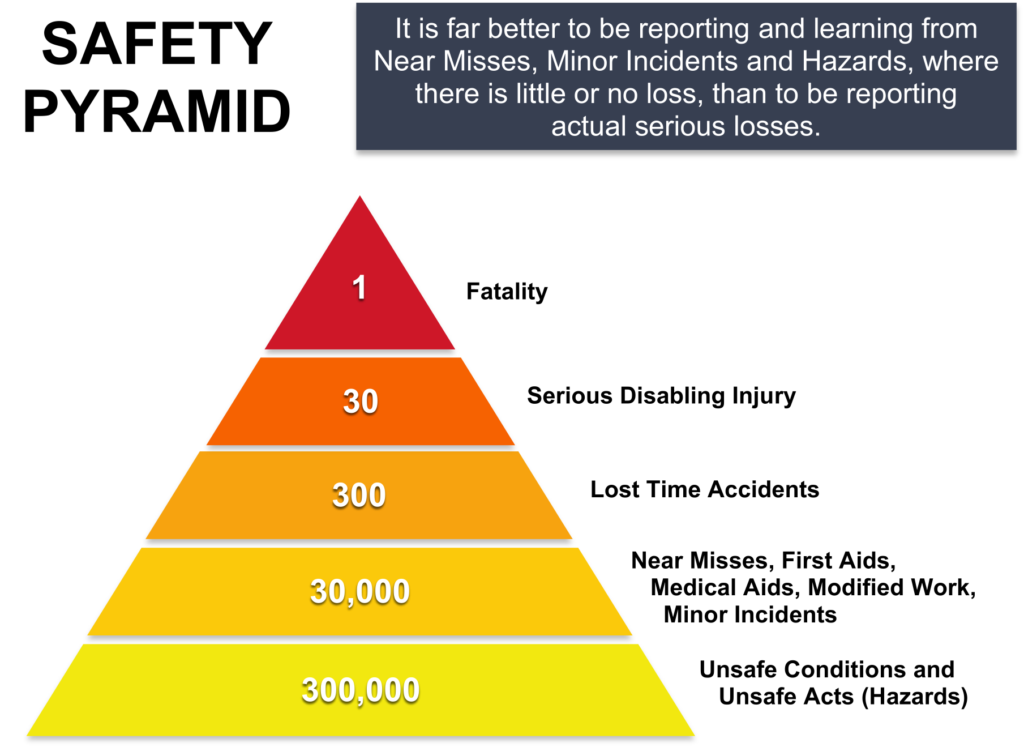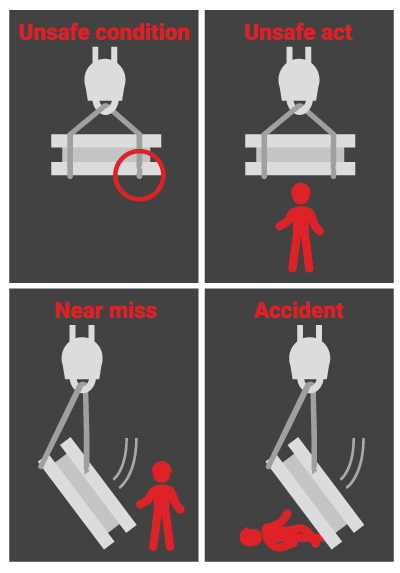Near Miss Reporting: The Safety Pyramid (Part 1)
Posted: Oct. 29, 2019 • By Kevin Kohler

It was a “near miss”, no one got hurt; so, we don’t call it an incident
A near miss should be treated like any other safety incident. A near miss is an incident that would have resulted in a loss such as an injury or property damage, under only slightly different circumstances. Often, only “luck” prevents a near miss from becoming a loss. An incident is an unplanned or unwanted event that resulted in, or could have resulted in, a loss.
What’s the “safety pyramid” where did it come from?
The “accident triangle” or “safety pyramid”, is a theory that there is a direct relationship between serious accidents, minor accidents and near misses.
Herbert Heinrich, a pioneer in workplace health and safety, first proposed the relationship in 1931 by determining that if minor accidents are reduced then there will be a corresponding fall in the number of serious accidents. Heinrich proposed a relationship of one major injury accident to 29 minor injury accidents, to 300 no-injury accidents. The relationship is often shown pictorially in the form of a triangle or pyramid.

In 1966 Frank Bird contributed to the theory based on his analysis of over 1.5 million accident reports. He produced a new triangle that showed a relationship of one serious injury accident to 10 minor injury accidents, to 30 damage causing accidents, to 600 near misses. Bird, like Heinrich, claimed that the majority of accidents could be predicted and prevented by acting on minor incidents and the behaviour of employees.
The safety pyramid has been called a cornerstone of health and safety for the last 80 or more years. Many safety systems include the premise that reporting and dealing with near miss incidents and their behavioural causes can nearly eliminate major accidents.
That’s good news, all we have to do is address our near misses?

It’s likely not that simple. There have been criticisms of the safety pyramid and the safety pyramid approach. The criticisms include:
The fixed ratios may not hold true: There is evidence that Heinrich’s and Bird’s ratios don’t hold true across all industries and workplaces.
The relationship may not apply across different hazard classes: Preventing minor incidents in one hazard class may not prevent major incidents in another unrelated hazard class.
The pyramid focuses mainly on unsafe behaviours: Serious accidents that occur infrequently can have complex causes.
It may seem intuitive to us (in hindsight) that fixed severity ratios should not stay the same over time, and across all industries and hazard classes. Infrequent major incidents may have complex causes that are unrelated to more common minor incidents.
Not throwing out the baby with the bathwater
Despite the criticisms, the safety pyramid approach to health and safety is still a valid approach if we:
- Worry less about the exact values of the ratios and the relationships and focus on what is going unreported and the value of reporting all near misses.
- Emphasize risk analysis so that we do not lose sight of low probability high impact incidents that may not be related to less serious near misses.
- Look beyond human behaviour for the root causes of near misses and incidents.
Regardless of the statistics and shape of the safety triangle, the emphasis on reporting all incidents, including near misses, and dealing with them to prevent actual losses, is a sound safety practice. We will discuss the value of this approach further in our follow-up blog on this topic.
Related Articles

Mental Health Effects during Isolation
It was a “near miss”, no one got hurt; so, we don’t call it an incident A near miss should […]
Read Article
Violence in the Workplace
It was a “near miss”, no one got hurt; so, we don’t call it an incident A near miss should […]
Read Article